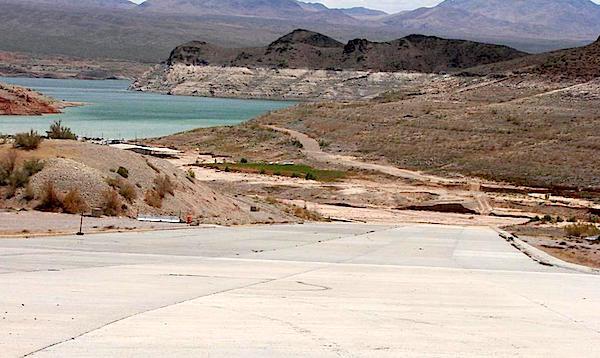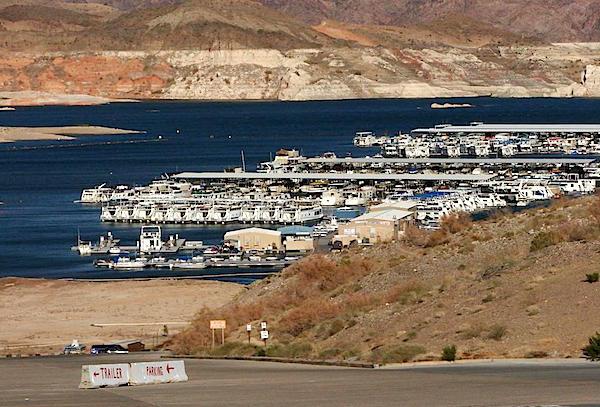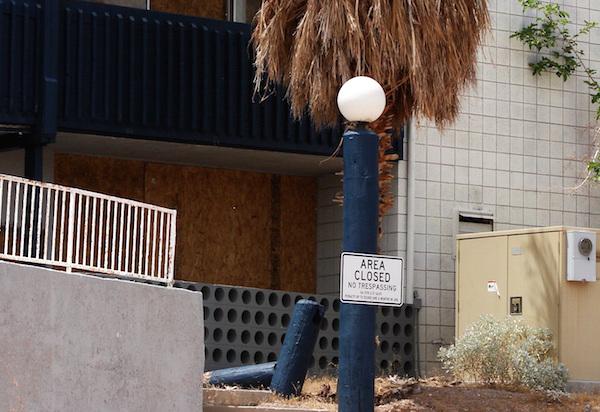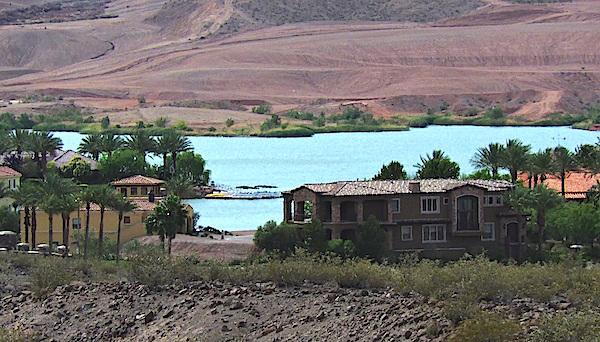I recently headed south from home toward Arizona where granddaughter No. 1 just finished becoming a mechanical engineer. The end of something like six years of grueling work ' with a cum laude to boot ' meant that a proud grandpa absolutely had to be in the crowd at Arizona State to cheer her on. She even managed to do it without student loans, although she does owe a bunch on the beautician's training that helped pay the bills.
Heck, her first job will pay her more than I ever made in my entire working life. But she certainly earned it. Her graduation gift from grandpappy came from an antique store. A real slide rule just like the ones my generation used back in the days "BC," before computers. She'd never actually seen one.

Years of drought have left the Echo Bay boat ramp beached./Lee Dalton
Okay, enough from the proud grandfather and now on to the less important part of this story.
Along the way, I stopped for a night at Lake Mead and had a chance to see for myself the dwindling puddle the lake that is the hallmark of this National Recreation Area is becoming. When I head south, I bypass Las Vegas by cutting off I-15 on Nevada Highway 169 through Overton and down past Valley of Fire State Park to Boulder City.
On a previous trip, I'd discovered a beautiful National Park Service camp at Callville Bay where campsites are walled in on three sides by oleanders with big red and white flowers.
There's a Lake Mead National Recreation Area entrance station in the middle of no place at the turnoff to Valley of Fire, but as has always been the case when I've passed by, it was not staffed. It appears to have been unused for a long time.
Hearing about how water levels have fallen at the NRA is one thing, but to actually see it is another.
The road leading to Overton Beach is closed. Blocked off by a bevy of barricades. There is no water visible from the highway. When I reached the turn-off to Echo Bay, I followed the road toward the lake out of curiosity and found a dismally depressing place.
The only person I met at Echo was a volunteer campground host in an otherwise empty campground. The paved boat launch ramp ends in a jumble of sand and a tangled pile of what was once a large complex of floating docks that sit on what was once the bottom of the lake. It's now shoreline.
There is a fairly new gravel road leading in a roundabout way to a place where, with caution, boats might still be launched, but signs warn of shallow water and possible damage to propellers. It looks like the Park Service is trying hard to keep at least a few boaters happy.
Back at the top of the hill is what remains of a once thriving complex of stores, motels, restaurants, employee housing and an apparently abandoned ranger station. Boarded up buildings are showing effects of desert country's harshness. Paint peels from walls, dirt and tumbleweeds clog what were busy entrances. Bare plywood covering windows and doors is delaminating in dry heat. It looks like something out of a post-apocalyptic movie.
I can't help thinking that I'm witnessing what must have been a personal tragedy for a lot of people whose livelihoods depended upon jobs here. There are signs that the camp host isn't the only human inhabitant left at Echo Bay, but it's apparent that not many are left.
Here stands mute testimony of the economic and human cost of the lack of water in the Colorado River. Even if river levels somehow return to 'normal' in some future scenario, restoring this place will certainly require an investment that will be in the millions of dollars.

Things are a bit better at Callville Bay, but for how long?/Lee Dalton
I head on south to Callville Bay and find things are a whole lot better.
The main paved boat launch ramp ends in sand instead of water and the Park Service has carved a new road to another temporary ramp where boats may still find water deep enough to navigate. The store and restaurant are still open ' although on shorter off-season schedules. The ranger station doesn't appear to have been completely abandoned.
Nothing is boarded up, and a large village of privately owned mobile homes sits in a trailer park where sites are leased from the concessionaire. There are a few campers in the campground amid the oleanders. In the evening when I walk down from the campground to the marina complex, I stand on the veranda outside the store and look toward the lake. Everywhere I look I can see signs that unless there are some dramatic changes sometime soon, Callville Bay's days are numbered.
A deep white bathtub ring surrounds the lake's blue water. Here and there along the shoreline sandbars bake in the evening sun. It all testifies to water lost to evaporation and the voracious appetite of human demands for water as cities and farms along the river's course have sucked up more and more of the precious liquid.
I wonder at all of this. I can remember the days when I was finishing high school and read about a place called Glen Canyon where another huge dam was being constructed to supposedly help ensure that water would forever be available to enable endless development in Southwestern deserts. There was also the promise that the new dam's hydropower would mean no more coal-fired electric plants would be needed and that thousands of jobs would save the entire region from poverty.
Where are those promises now?
Was what I witnessed at Callville that evening a story of deliberate deceit, or was it simply short-sighted seeking of temporary gains? Was it just poor planning, or was it a reflection of willful ignorance? Did we, at some time when no one knew it was happening, reach a tipping point where water consumption passed the point of sustainability?

Times are so slow that the Echo Bay lodge has closed/Lee Dalton
Have we learned anything from lakes Mead and Powell?
From the veranda at Callville Bay and the sun-seared ruins at Echo, it would appear we have not. I hear that the city of Las Vegas is digging a new, much deeper water intake tunnel to allow them to continue to pull water from Lake Mead as it shrinks still more. As I pass through Boulder City, I see endless waves of new developments and even a large artificial lake surrounded by 'megamansions.'
In Utah, the legislature just appropriated again a fistful of taxpayer dollars to continue 'studying' (that really means lobbying for) construction of a $2.5 billion pipeline from Lake Powell to feed even more development around St. George.
In the meantime, arguments swirl like sand in a dust devil as various groups debate endlessly about such things as development, drought, climate change, economics and profits and losses, and something their public relations agents call economic opportunities and jobs and visions for the future. We hear more promises that pipelines and wells dug deep into ancient aquifers in places like Snake Valley will ensure a utopian future for everyone. Bright visions of the future fed by endless funds from a few who stand to gain great profits.
Visions? Or hallucinations?
How can we know? Who shall we believe? Will most of us even care until those visions rear up to bite us when it's too late? Where is real wisdom when we really need it? Will people like my granddaughter, whose new engineering skills will be used by a large Arizona company that deals with water and electric power and dams and canals, somehow be able to make wise decisions to guide us into a future without disaster?
Lordy, I sure hope so. I won't be here to see it, but my other granddaughters will. So will yours.

Water flows uphill to money, as this private oasis seems to indicate/Lee Dalton.



Comments
Thank you Lee for sharing your personal experiences at Lake Mead with us. It's an outstanding article.
There are many interesting NPS sites around the area showcasing civilization swells, and then village/site abandoment due to long term mega droughts - Mesa Verde, Chaco Canyon, the Grand Canyon, Wupatki, and the list goes on. It's happening again, although I fear this one is going to be worse because the population numbers are much much greater. Back then there weren't millions sucking down water resources in places like Phoenix, Vegas, San Diego, and LA like there are today. So, the severity will more than likely be much more catastrophic. This is just the tip of the iceberg.
Great article with some sad news. Echo Bay is a much different place than it was when I worked there 30 years ago.
So why not drain Lake Powell and send that water to Lake Mead instead of building a giant pipeline to divert water from the edge of the Great Basin to "Lost" Vegas? Wasn't Lake Powell supposed to hold additional "surplus" water above Lake Mead in case it was needed in Vegas or further down the Colorado destribution points? As it is now, millions of acre feet of water evaporate into the sky above Lake Powell each year instead of providing water to Vegas and recreation on Lake Mead.
I was always under the assumption that Lake Mead was what built Vegas, not vice versa. There's a satellite timelapse from NASA that they put out showcasing the rise, and fall of Lake Mead over the course of 30 or 40 years, and it was pretty telling what has happened. You basically see Lake Mead shrink as Vegas bursts outward. I'll try and dig up that video later today. So, it seems that even if that water was there, it would be squandered by just accelerating more growth in Lost Wages.
Lake Mead as I remember it from 1973-1977 is so different from today. I am sure I would have difficulty recognizing Echo Bay and the Overton Area. I was assigned to Callville Bay but spent time on all areas of the lake including Temple Bar, and of course, Las Vegas Wash and Boulder Beach. It was a great time to be a Park Ranger at Lake Mead. Many good memories of Lakes Mead and Mohave but also some sad ones, including the flash flood at Eldorado Canyon that took the lives of a Park Ranger's wife and two boys. It is something that has stayed with me all these years because I was the first one to arrive at the scene of the devastation. Living and working at the two lakes back then was an experience I will always cherish.
What about the recreation the water provides at Lake Powell? Maybe if we had less fountains and pools in Las Vegas and shortened our daily showers a bit both lakes could be there for our enjoyment.
I agree there seems to be room for improvements in conservation of water in places like Las Vegas.
There is some interesting information concerning domestic water use on the website for the Council of State Governments West. According to that site, domestic water use per capita is higher in Nevada (190 gallons per day) than in any other western state, and nearly twice the national average (98 gallons per day).
I can't vouch for the accuracy this data, but the numbers are similar to those from the Las Vegas Valley Water District, which says, "Southern Nevada has reduced its total system GPCD (gallons per capita per day) demand from about 314 GPCD to 205 GPCD in 2014. The community in 2014 also achieved a net GPCD of 118, which accounts for water recycling that allows water to be used more than once.
A related issue, of course, is that even with reduced use per person, the number of people in many locations (including S. Nevada) continues to grow; the result is increasing total demand for water.